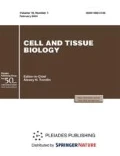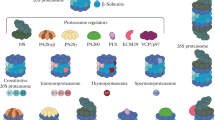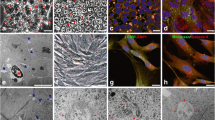Abstract
Embryonic stem cells (ESCs), and their artificial counterparts, induced pluripotent stem cells (iPSCs) give rise to all differentiated cell types in adult organism.Therefore, pluripotent cells are an inexhaustible cell source for regenerative medicine. However, the successful clinical application of ESCs and iPSCs is associated with the risk of teratoma formation after transplantation of their differentiated products. Oncogenic potential is believed to be associated with the preservation of pluripotent cells resistant to differentiation. For unknown reason under mitogenic stimuli these defective cells did not activate the mechanisms of exit from pluripotency and remained undifferentiated. During embryogenesis, there are special mechanisms for eliminating the abnormal cells unsuitable for embryo development, which are massively triggered before gastrulation, the initial stage of cell differentiation into germ layers. It is known that, prior to implantation, autophagy plays a critical role in embryo formation and can be considered as one of the main cellular strategies aimed at large-scale restructuring of intracellular material after fertilization. It can be proposed that unless massive intracellular reorganization of embryonic cells occur effective, such cells will have defective proteostasis, affecting their differentiation potential. Therefore, the high level of apoptosis observed before gastrulation in embryogenesis is associated with the elimination of mutant cells that are not suitable for differentiation. Damaged cells are marked with the activated p53 protein indicating the p53-dependent elimination mechanisms. And, apparently, the mechanism of the p53 activation is associated with damaged cellular proteostasis, regulated by autophagy. Thus, the p53-dependent autophagy can play a key role in determining the fate of pluripotent cells: induction of cell death and/or resistance to differentiation. We have shown that the p53 protein is tightly integrated with autophagy and, under defective proteostasis, p53 effectively induces autophagy-mediated cell death in pluripotent cells.


Similar content being viewed by others
REFERENCES
Amir, H., Touboul, T., Sabatini, K., Chhabra, D., Garitaonandia, I., Loring, J.F., Morey, R., and Laurent, L.C., Spontaneous single-copy loss of TP53 in human embryonic stem cells markedly increases cell proliferation and survival, Stem Cells, 2017, vol. 35, p. 872.
Baker, D.E.C., Harrison, N.J., Maltby, E., Smith, K., Moore, H.D., Shaw, P.J., Heath, P.R., Holden, H., and Andrews, P.W., Adaptation to culture of human embryonic stem cells and oncogenesis in vivo, Nat. Biotechnol., 2007, vol. 25, p. 207.
Bowling, S., Di, Gregorio, A., Sancho, M., Pozzi, S., Aarts, M., Signore, M., Schneider, M.D., Martinez-Barbera, J.P., Gil, J., and Rodríguez, T.A., P53 and mTOR signalling determine fitness selection through cell competition during early mouse embryonic development, Nat. Commun., 2018, vol. 9, p. 1763.
Budanov, A.V., and Karin, M., The p53-regulated sestrin gene products inhibit mTOR signaling, Cell, 2008, vol. 134, p. 451.
Cho, S.J., Kim, K.T., Jeong, H.C., Park, J.C., Kwon, O.S., Song, Y.H., Shin, J.G., Kang, S., Kim, W., Shin, H.D., Lee, M.O., Moon, S.H., and Cha, H.J., Selective elimination of culture-adapted human embryonic stem cells with BH3 mimetics, Stem Cell Rep., 2018, vol. 11, p. 1244.
Crighton, D., Wilkinson, S., O’Prey, J., Syed, N., Smith, P., Harrison, P.R., Gasco, M., Garrone, O., Crook, T., and Ryan, K.M., DRAM, a p53-induced modulator of autophagy, is critical for apoptosis, Cell, 2006, vol. 126, p. 121.
Draper, J.S., Smith, K., Gokhale, P., Moore, H.D., Maltby, E., Johnson, J., Meisner, L., Zwaka, T.P., Thomson, J.A., and Andrews, P.W., Recurrent gain of chromosomes 17q and 12 in cultured human embryonic stem cells, Nat. Biotechnol., 2004, vol. 22, p. 53.
Eby, K.G., Rosenbluth, J.M., Mays, D.J., Marshall, C.B., Barton, C.E., Sinha, S., Johnson, K.N., Tang, L., and Pietenpol, J.A., ISG20L1 is a p53 family target gene that modulates genotoxic stress-induced autophagy, Mol. Cancer, 2010, vol. 9, p. 95.
Feng, Z., Hu, W., de, Stanchina, E., Teresky, A.K., Jin, S., Lowe, S., and Levine, A.J., The regulation of AMФK beta1, TSC2, and PTEN expression by p53: stress, cell and tissue specificity, and the role of these gene products in modulating the IGF-1-AKT-mTOR pathways, Cancer Res., 2007, vol. 67, p. 3043.
Gangloff, Y.-G., Mueller, M., Dann, S.G., Svoboda, P., Sticker, M., Spetz, J.-F., Um, S.H., Brown, E.J., Cereghini, S., Thomas, G., and Kozma, S.C., Disruption of the mouse mTOR gene leads to early postimplantation lethality and prohibits embryonic stem cell development, Mol. Cell. Biol., 2004, vol. 24, p. 9508.
Gao, W., Shen, Z., Shang, L., and Wang, X., Upregulation of human autophagy-initiation kinase ULK1 by tumor suppressor p53 contributes to DNA-damage-induced cell death, Cell Death Differ., 2011, vol. 18, p. 1598.
García, C.P., Videla, Richardson, G.A., Dimopoulos, N.A., Fernandez, Espinosa, D.D., Miriuka, S.G., Sevlever, G.E., Romorini, L., and Scassa, M.E., Human pluripotent stem cells and derived neuroprogenitors display differential degrees of susceptibility to BH3 mimetics ABT-263, WEHI-539 and ABT-199, PLoS One, 2016, vol. 11. e0152607.
Gong, J., Gu, H., Zhao, L., Wang, L., Liu, P., Wang, F., Xu, H., and Zhao, T., Phosphorylation of ULK1 by AMФK is essential for mouse embryonic stem cell self-renewal and pluripotency. Cell Death Dis., 2018, vol. 9, p. 38.
Grigorash, B.B., Suvorova, I.I., and Pospelov. V.A., AICAR-dependent activation of AMФK kinase is not accompanied by G1/S block in mouse embryonic stem cells, Mol. Biol., 2018, vol. 52, p. 499.
Hardie, D.G., Schaffer, B.E., and Brunet, A., AMФK: an energy-sensing pathway with multiple inputs and outputs, Trends Cell Biol., 2016, vol. 26, p. 190.
Heyer, B.S., MacAuley, A., Behrendtsen, O., and Werb, Z., Hypersensitivity to DNA damage leads to increased apoptosis during early mouse development, Genes Dev., 2000, vol. 14, p. 2072.
Jones, R.G., Plas, D.R., Kubek, S., Buzzai, M., Mu, J., Xu, Y., Birnbaum, M.J., and Thompson, C.B., AMP-activated protein kinase induces a p53-dependent metabolic checkpoint, Mol. Cell, 2005, vol. 18, p. 283.
Kenzelmann, Broz, D., Spano, Mello, S., Bieging, K.T., Jiang, D., Dusek, R.L., Brady, C.A., Sidow, A., and Attardi, L.D., Global genomic profiling reveals an extensive p53-regulated autophagy program contributing to key p53 responses, Genes Dev., 2013, vol. 27, p. 1016.
Kim, J., Yang, G., Kim, Y., Kim, J., and Ha, J., AMФK activators: mechanisms of action and physiological activities, Exp. Mol. Med., 2016, vol. 48. e224. https://doi.org/10.1038/emm.2016.16
Levayer, R., and Moreno, E., Mechanisms of cell competition: themes and variations, J. Cell Biol., 2013, vol. 200, p. 689.
Li, M., He, Y., Dubois, W., Wu, X., Shi, J., and Huang, J., Distinct regulatory mechanisms and functions for p53-activated and p53-repressed DNA damage response genes in embryonic stem cells, Mol. Cell, 2012, vol. 46, p. 30.
Lin, T., and Lin, Y., p53 switches off pluripotency on differentiation, Stem Cell Res. Ther., 2017, vol. 8, p. 44.
Malik, S.A., Orhon, I., Morselli, E., Criollo, A., Shen, S., Mariño, G., BenYounes, A., Bénit, P., Rustin, P., Maiuri, M.C., and Kroemer, G., BH3 mimetics activate multiple pro-autophagic pathways, Oncogene, 2011, vol. 30, p. 3918.
Manova, K., Tomihara-Newberger, C., Wang, S., Godelman, A., Kalantry, S., Witty-Blease, K., De, Leon, V., Chen, W.S., Lacy, E., and Bachvarova, R.F., Apoptosis in mouse embryos: elevated levels in pregastrulae and in the distal anterior region of gastrulae of normal and mutant mice. Dev. Dynam., 1998, vol. 213, p. 293.
Mathieu, J., Detraux, D., Kuppers, D., Wang, Y., Cavanaugh, C., Sidhu, S., Levy, S., Robitaille, A.M., Fer-reccio, A., Bottorff, T., McAlister, A., Somasundaram, L., Artoni, F., Battle, S., D.Hawkins, R., Moon, R.T., Ware, C.B., Paddison, P.J., and Ruohola-Baker, H., Folliculin regulates mTORC1/2 and WNT pathways in early human pluripotency, Nat. Commun., 2019, vol. 10, p. 632.
Moreno, E., Basler, K., and Morata, G., Cells compete for decapentaplegic survival factor to prevent apoptosis in Drosophila wing development, Nature, 2002, vol. 416, p. 755.
Morselli, E., Tasdemir, E., Maiuri, M.C., Galluzzi, L., Kepp, O., Criollo, A., Vicencio, J.M., Soussi, T., and Kroemer, G., Mutant p53 protein localized in the cytoplasm inhibits autophagy, Cell Cycle (Georgetown, Tex.), 2008, vol. 7, p. 3056.
Murakami, M., Ichisaka, T., Maeda, M., Oshiro, N., Hara, K., Edenhofer, F., Kiyama, H., Yonezawa, K., and Yamanaka, S., mTOR is essential for growth and proliferation in early mouse embryos and embryonic stem cells, Mol. Cell. Biol., 2004, vol. 24, p. 6710.
Parzych, K.R., and Klionsky, D.J., An overview of autophagy: morphology, mechanism, and regulation, Antioxid. Redox Signal., 2014, vol. 20, p. 460.
Possik, E., Jalali, Z., Nouët, Y., Yan, M., Gingras, M.-C., Schmeisser, K., Panaite, L., Dupuy, F., Kharitidi, D., Chotard, L., Jones, R.G., Hall, D.H., and Pause, A., Folliculin regulates AMФK-dependent autophagy and metabolic stress survival, PLoS Genetics, 2014, vol. 10. e1004273. https://doi.org/10.1371/journal.pgen.1004273
Sancho, M., Di-Gregorio, A., George, N., Pozzi, S., Sánchez, J.M., Pernaute, B., and Rodríguez, T.A., Competitive interactions eliminate unfit embryonic stem cells at the onset of differentiation, Dev. Cell, 2013, vol. 26, p. 19.
Schier, A.F., The maternal-zygotic transition: death and birth of RNAs, Science, 2007, vol. 316, p. 406.
Speidel, D., The role of DNA damage responses in p53 biology, Arch. Toxicol., 2015, vol. 89, p. 501.
Spits, C., Mateizel, I., Geens, M., Mertzanidou, A., Staessen, C., Vandeskelde, Y., Van der Elst, J., Liebaers, I., and Sermon, K., Recurrent chromosomal abnormalities in human embryonic stem cells, Nat. Biotechnol., 2008, vol. 26, p. 1361.
Spruce, T., Pernaute, B., Di-Gregorio, A., Cobb, B.S., Merkenschlager, M., Manzanares, M., and Rodriguez, T.A., An early developmental role for miRNAs in the maintenance of extraembryonic stem cells in the mouse embryo, Dev. Cell, 2010, vol. 19, p. 207.
Suvorova, I.I., Knyazeva, A.R., and Pospelov, V.A., Resveratrol-induced p53 activation is associated with autophagy in mouse embryonic stem cells, Biochem. Biophys. Res. Commun., 2018, vol. 503, p. 2180.
Suvorova, I.I., Knyazeva, A.R., Petukhov, A.V., Aksenov, N.D., and Pospelov, V.A., Resveratrol enhances pluripotency of mouse embryonic stem cells by activating AMФK/Ulk1 pathway, Cell Death Dis., 2019, vol. 5, p. 61.
Tasdemir, E., Maiuri, M.C., Galluzzi, L., Vitale, I., Djavaheri-Mergny, M., D’Amelio, M., Criollo, A., Morselli, E., Zhu, C., Harper, F., Nannmark, U., Samara, C., Pinton, P., Vicencio, J.M., Carnuccio, R., Moll, U.M., Madeo, F., Paterlini-Brechot, P., Rizzuto, R., Sza-badkai, G., Pierron, G., Blomgren, K., Tavernarakis, N., Codogno, P., Cecconi, F., and Kroemer, G., Regulation of autophagy by cytoplasmic p53, Nat. Cell Biol., 2008, vol. 10, p. 676.
Tsukamoto, S., Kuma, A., Murakami, M., Kishi, C., Yamamoto, A., and Mizushima, N., Autophagy is essential for preimplantation development of mouse embryos, Science, 2008, vol. 321, p. 117.
Wang, S., Xia, P., Ye, B., Huang, G., Liu, J., and Fan, Z., Transient activation of autophagy via Sox2-mediated suppression of mTOR is an important early step in reprogramming to pluripotency, Cell Stem Cell, 2013, vol. 13, p. 617.
Funding
This work was financially supported by the Russian Foundation for Basic Research, project no. 18-015-00230A.
Author information
Authors and Affiliations
Corresponding author
Ethics declarations
The authors declare that they have no conflict of interest.
The authors did not perform experiments with animals or human beings as subjects.
Additional information
Abbreviations: IPSC—induced pluripotent stem cell; ESC—embryonic stem cells, ADP and AMP—adenosindi and adenosine monophosphate, respectively; AMPK—AMP-activated protein kinase; mTOR—mammalian rapamycin target (mammalian target of rapamycin).
Rights and permissions
About this article
Cite this article
Sutula, G.I., Vorobev, M.L. & Suvorova, I.I. The Role of P53-Dependent Autophagy in the Regulation of Pluripotent Cell Bevavior. Cell Tiss. Biol. 14, 332–340 (2020). https://doi.org/10.1134/S1990519X20050089
Received:
Revised:
Accepted:
Published:
Issue Date:
DOI: https://doi.org/10.1134/S1990519X20050089




